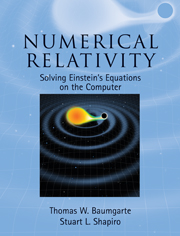Book contents
- Frontmatter
- Contents
- Preface
- Suggestions for using this book
- 1 General relativity preliminaries
- 2 The 3 + 1 decompostion of Einstein's equations
- 3 Constructing initial data
- 4 Choosing coordinates: the lapse and shift
- 5 Matter sources
- 6 Numerical methods
- 7 Locating black hole horizons
- 8 Spherically symmetric spacetimes
- 9 Gravitational waves
- 10 Collapse of collisionless clusters in axisymmetry
- 11 Recasting the evolution equations
- 12 Binary black hole initial data
- 13 Binary black hole evolution
- 14 Rotating stars
- 15 Binary neutron star initial data
- 16 Binary neutron star evolution
- 17 Binary black hole–neutron stars: initial data and evolution
- 18 Epilogue
- A Lie derivatives, Killing vectors, and tensor densities
- B Solving the vector Laplacian
- C The surface element on the apparent horizon
- D Scalar, vector and tensor spherical harmonics
- E Post-Newtonian results
- F Collisionless matter evolution in axisymmetry: basic equations
- G Rotating equilibria: gravitational field equations
- H Moving puncture representions of Schwarzschild: analytical results
- I Binary black hole puncture simulations as test problems
- References
- Index
13 - Binary black hole evolution
Published online by Cambridge University Press: 05 March 2013
- Frontmatter
- Contents
- Preface
- Suggestions for using this book
- 1 General relativity preliminaries
- 2 The 3 + 1 decompostion of Einstein's equations
- 3 Constructing initial data
- 4 Choosing coordinates: the lapse and shift
- 5 Matter sources
- 6 Numerical methods
- 7 Locating black hole horizons
- 8 Spherically symmetric spacetimes
- 9 Gravitational waves
- 10 Collapse of collisionless clusters in axisymmetry
- 11 Recasting the evolution equations
- 12 Binary black hole initial data
- 13 Binary black hole evolution
- 14 Rotating stars
- 15 Binary neutron star initial data
- 16 Binary neutron star evolution
- 17 Binary black hole–neutron stars: initial data and evolution
- 18 Epilogue
- A Lie derivatives, Killing vectors, and tensor densities
- B Solving the vector Laplacian
- C The surface element on the apparent horizon
- D Scalar, vector and tensor spherical harmonics
- E Post-Newtonian results
- F Collisionless matter evolution in axisymmetry: basic equations
- G Rotating equilibria: gravitational field equations
- H Moving puncture representions of Schwarzschild: analytical results
- I Binary black hole puncture simulations as test problems
- References
- Index
Summary
The dynamical simulation of the head-on collision of two black holes in axisymmetry was an early success of numerical relativity (see Chapter 10.2). Based on this success one might surmise that the subsequent simulation of the inspiral and merger of binary black holes initially in circular orbit represented a straightforward generalization of the head-on case. It turned out, however, that relaxing the assumption of axisymmetry to treat a binary in circular orbit, and then tracking the resulting evolution, presented several nontrivial challenges. As a consequence, dynamical simulations of these binaries were stalled for many years until these challenges were finally overcome. Today, the inspiral and merger of binary black holes is essentially a solved problem, constituting one of the major triumphs of numerial relativity.
One obvious complication that arises in numerical simulations when moving from two to three spatial dimensions is the burden of increased computational resources required to cover the added dimension. Even though computers have become considerably faster and can handle far more memory than the machines available when the first head-on black hole simulations were performed, the resources required to resolve inspiraling black holes in the strong-field, near-zone while simultaneously tracking and ultimately extracting gravitational waves in the weak-field, far-zone remain formidable. Different investigators have adopted different approaches to address this problem of “dynamic range”, including the use of fixed or adaptive mesh refinement or the construction of novel coordinate systems that allocate gridpoints where they are most needed.
- Type
- Chapter
- Information
- Numerical RelativitySolving Einstein's Equations on the Computer, pp. 429 - 458Publisher: Cambridge University PressPrint publication year: 2010



